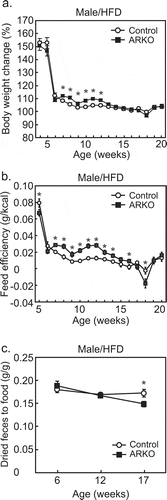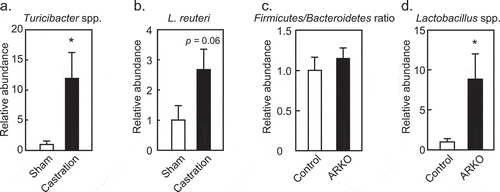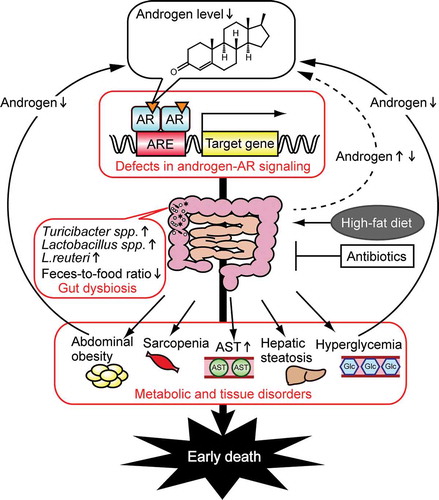Figures & data
Figure 1. Effects of androgen receptor knockout (ARKO) on body weight gain, feed efficiency, and digestive efficiency in male mice fed a high-fat diet (HFD). Mice were fed an HFD up to 20-weeks of age, as previously described.Citation27 (a) Changes in body weight (%) and (b) feed efficiency (body weight gain/food intake) were determined once a week (control, n = 16; ARKO, n = 19). (c) Digestive efficiency (dried fecal weight/food intake) was determined at 6, 12, and 17 weeks (n = 11). Data were expressed as mean ± SEM, and the threshold for statistical significance was set at p < .05, *.

Figure 2. Effects of androgen receptor knockout (ARKO) or castration on fecal microbiota of male mice fed a high-fat diet (HFD). In castration and ARKO models, mice were fed an HFD, as previously described.Citation26,Citation27 Feces were collected at 13 (castration) or 17 (ARKO) weeks of age and extracted DNA was analyzed by real-time PCR with specific primers.Citation26,Citation27 Relative abundance of (a) Turicibacter and (b) Lactobacillus reuteri in the castration model (HFD sham, n = 8; HFD castration, n = 9). (c) Firmicutes to Bacteroidetes ratio, and (d) Lactobacillus species in the ARKO model (n = 11) is also represented. Data were expressed as mean ± SEM, and the threshold for statistical significance was set at p < .05, *.

Figure 3. Effects of androgen receptor knockout (ARKO) on plasma transaminase levels in male mice. Control mice and ARKO mice were fed either a standard (SD) or a high-fat diet (HFD) and up to 20-weeks of age, as previously described.Citation27 Levels of (a) plasma alanine aminotransferase (ALT) and (b) plasma aspartate aminotransferase (AST) were measured using a Transaminase CII-test Wako (Wako, Osaka, Japan). SD male experimental groups included control (n = 5) and ARKO (n = 6). HFD male experimental groups included control (n = 18) and control treated with antibiotics (n = 9, Abs), ARKO (n = 12), and ARKO treated with antibiotics (n = 10). HFD female experimental groups were control (n = 5) and ARKO (n = 7). Data were expressed as mean ± SEM, and the threshold for statistical significance was set at p < .05, *.

Figure 4. Schematic of the effects of androgen on metabolic disorders in males. Defects in androgen–androgen receptor (AR) signaling (including castration and ARKO) cause gut dysbiosis, result in abdominal obesity, hyperglycemia, hepatic steatosis, sarcopenia, and also increase aspartate aminotransferase (AST) levels, leading to early death.Citation24,Citation26,Citation27 Androgens levels are decreased by obesity and hyperglycemia, and are regulated by gut microbiota. ARE, androgen response element; Glc, glucose.

